A Benefit of Membership in the R&LHS
Railroad History, known as the R&LHS Bulletin from 1921 until 1972, is the oldest railroad history journal in North America. It contains original scholarship and fresh interpretations that set the standard in railway research. Here are carefully selected articles, photographs, and art. It is issued twice yearly in an 8¼ by 10½-inch perfect-bound paperback edition and is included in R&LHS membership. Its Book Division has the most complete reviews anywhere of the latest books about railroads and traction. The journal is indexed by America: History and Life, a database available at major research libraries, and on this site. JSTOR (an acronym for Journal Storage) has a searchable digital archive of the R&LHS Bulletin (1921-1972) and Railroad History (1972-up to a rolling date five years before the current date.)
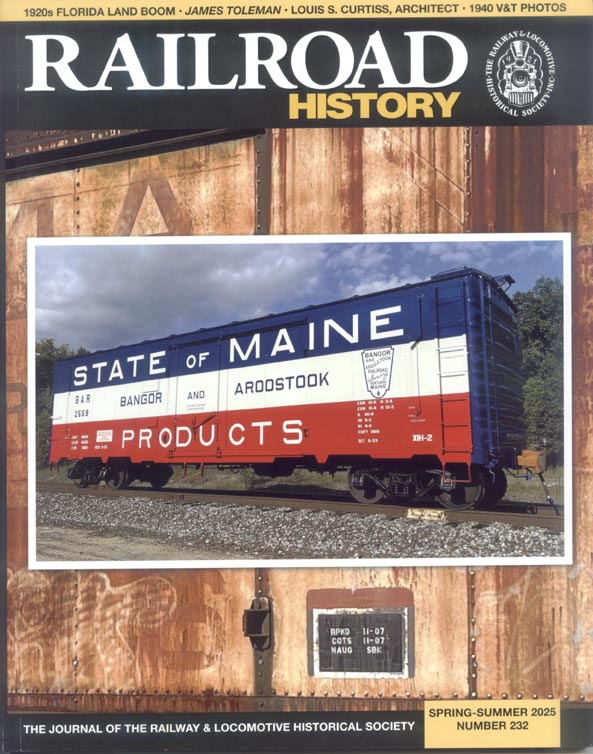 |
Railroad History 232 Spring-Summer 2025. (Current Issue)
|
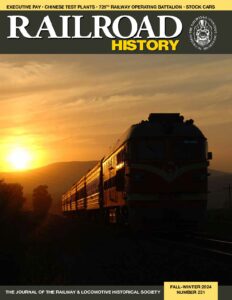 |
Railroad History 231 Fall/Winter 2024
|
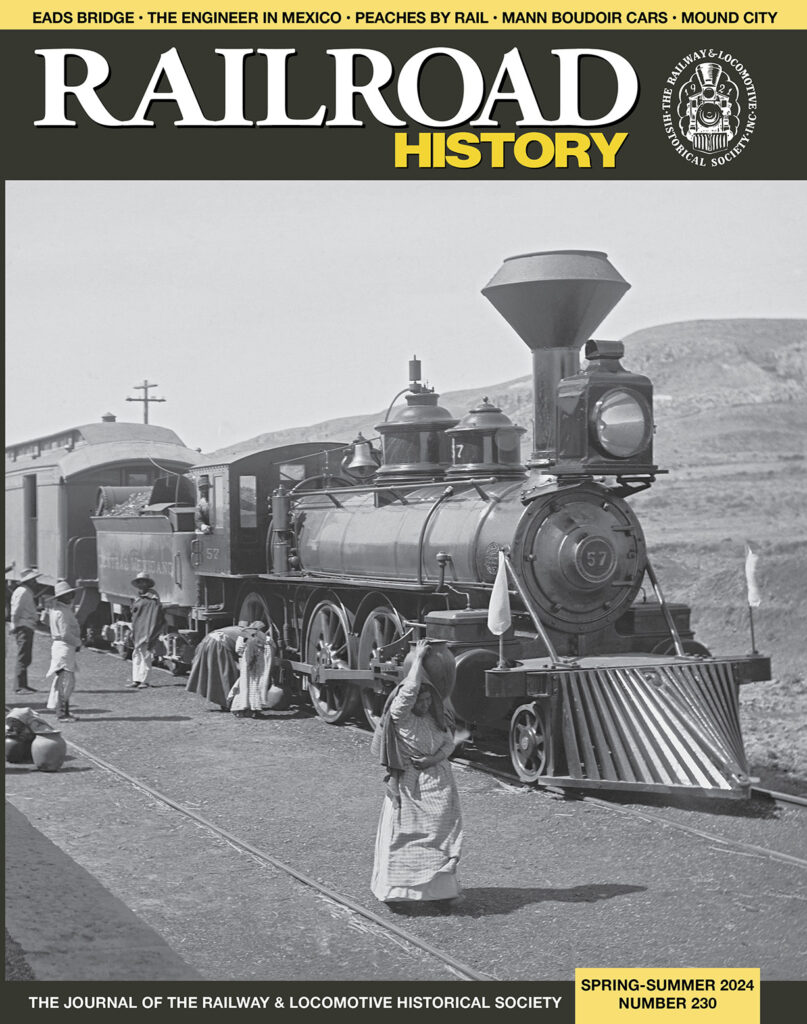 |
Railroad History 230 Spring/Summer 2024
Plus:
|
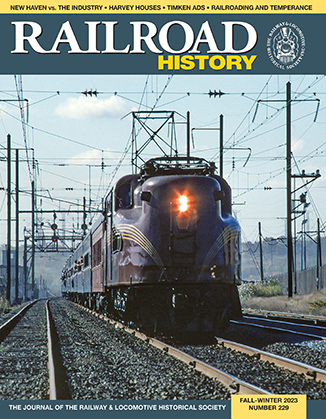 |
Railroad History 229 Fall/Winter 2023
Plus:
|
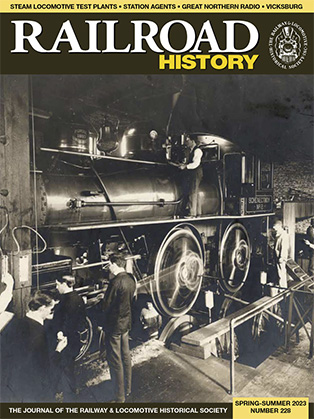 |
Railroad History 228 Spring/Summer 2023
|
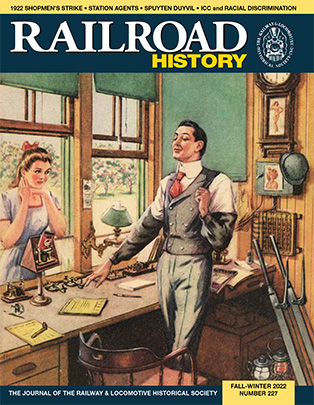 |
Railroad History 227 Fall/Winter 2022
|
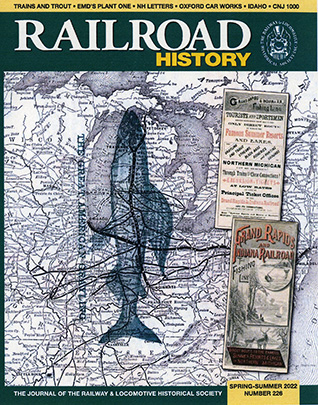
|
Railroad History 226 Spring/Summer 2022
|
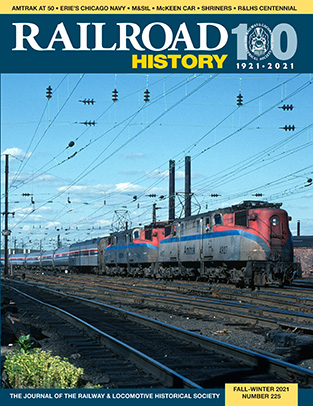 |
Railroad History 225 Fall/Winter 2021
|
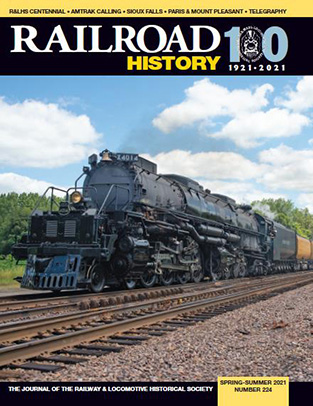 |
Railroad History 224 Spring/Summer 2021
|
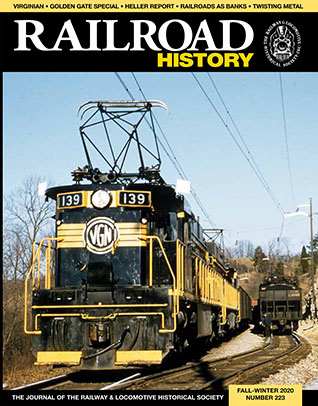 |
Railroad History 223 Fall/Winter 2020
|
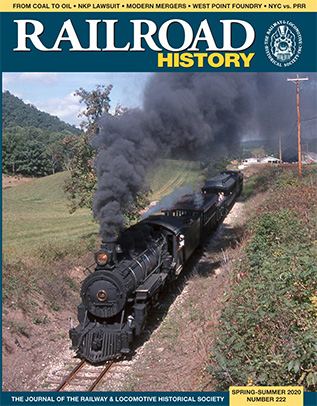 |
Railroad History 222 Spring/Summer 2020
|
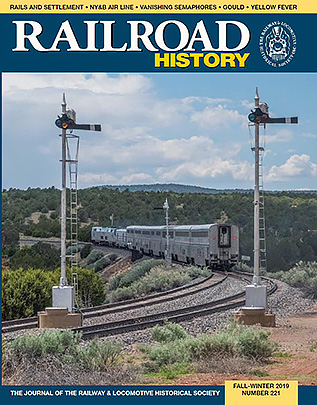 |
Railroad History 221 Fall/Winter 2019
|
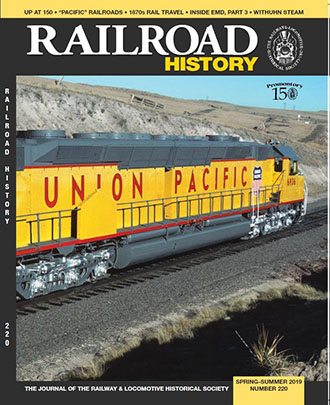 |
Railroad History 220 Spring/Summer 2019
|
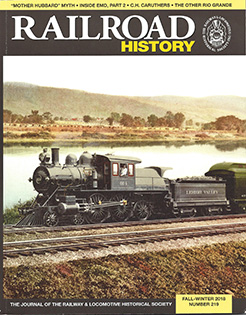 |
No. 219 – Fall/Winter 2018
|
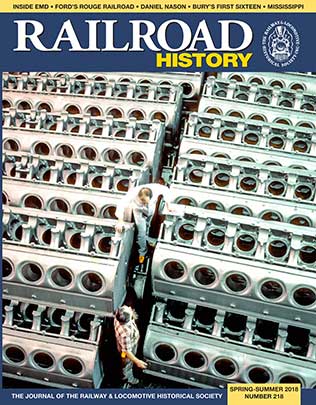 |
No. 218 Spring-Summer 2018 (Out-of-print)
|
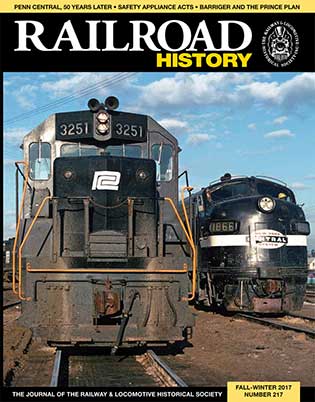 |
No. 217 Winter-Fall 2017
|
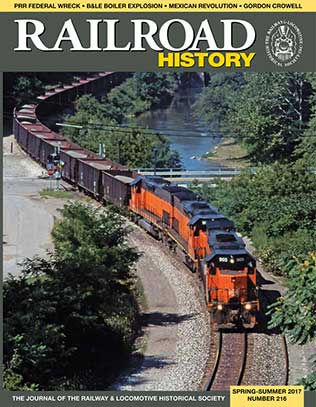 |
No. 216 Spring-Summer 2017
|
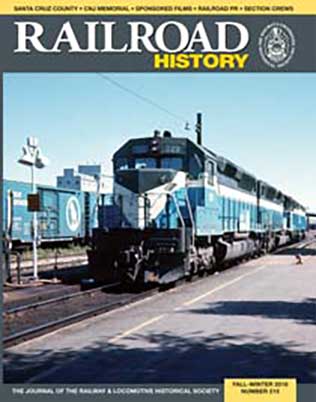 |
No. 215 Fall-Winter 2016
|
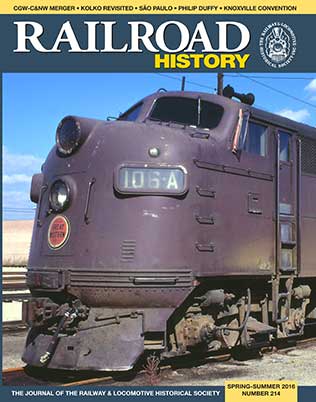 |
No. 214 Spring-Summer 2016 Ralph Rotten and the Chicago Great Western, How to merge a regional carrier into a larger railroad. James L. Larson Gabriel Kolko Revisited Railroads and Regulation, 50 years after its publication. William D. Burt Railways in South America’s Largest City São Paulo, Brazil, in 1974. J. Parker Lamb and Thomas Correa The Knoxville Convention, Recalling an 1836 effort to link Charleston, S.C., with the Ohio River. H. Roger Grant Who Was Philip Duffy? Examining the life of an Irish- American railroad contractor. J. Francis Watson Short Takes: A Spy? No, Just a Photographer (Lucius Beebe). John GruberCover: Chicago Great Western F3A locomotive No. 106A at Chicago in September 1968, soon after CGW was merged into Chicago & North Western. J. W. Seidl |
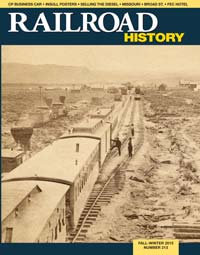 |
No. 213 Fall/Winter 2015 Selling the Diesel: The history of locomotive sales and marketing practices in the diesel era. Preston Cook Ponce de Leon, A Flagler Hotel: Reflections on a repurposed 19th-century Florida landmark. Richard W. Luckin The North Missouri, Bridging the Missouri River: and other achievements. H. Roger Grant Meeting an Emergency: How the Pennsylvania Railroad coped with conflagration at Broad Street Station, Philadelphia. Eric A. Sibul Ph.D From Golden Spike to Silver Screen: The improbable story of a Central Pacific Railroad business car. Peter A. Hansen Chicago: Colorful, creative posters and a 1920s multimedia campaign. John Gruber and J.J. SedelmaierCover: Central Pacific director’s car at Carlin, Nevada, about 1869. Nevada State Railroad Museum |
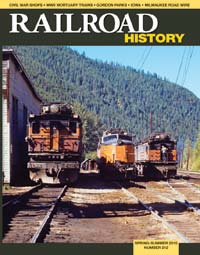 |
No. 212 Spring/Summer 2015 Alexandria, Virginia, Shops of the U.S. Military Railroads. A close look at an important Civil War railroad facility. John H. White, Jr. The Last Train Ride: Repatriating the remains of America’s World War II dead. James I. Murrie and Naomi Jeffey Petersen Gordon Parks’ Images of Washington Union Station. A wartime crossroads viewed through perceptive eyes. Tony Reevy Demise Postponed. Iowa’s electric interurban railways and World War II. Don L. Hofsommer Milwaukee Road’s Electrification. The origins and evolution of catenary on the Pacific Coast Extension. Adam T. Michalski Cover: Milwaukee Road at Avery, Idaho. Mike Schafer |
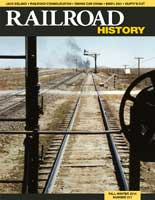 |
No. 211 Fall/Winter 2014 If there’s a theme, it could be this: There are a lot of stories behind the stories we know so well. Start with the checkered history of railroad regulation. By kind permission of Harvard University Press, we present a chapter from Robert Gallamore’s new book, American Railroads: Decline and Renaissance in the Twentieth Century. Elsewhere, we look at photographer Jack Delano’s trip west on the Santa Fe Railway in 1943. John Gruber has ferreted out the human stories behind the pictures. The Irish provided the muscle that built many of the nation’s railroads, and they lived hard lives. William Watson of Immaculata University reports on the excavation of a mass grave dating from the 1830s. Preston Cook presents the story of Electro-Motive’s 25th anniversary, and Richard Luckin considers the elite passenger trains that had their own china. This issue is full of new stories, and of new takes on old stories. Cover: A classic Santa Fe Railway signal tower frames Jack Delano’s 1943 shot at Melrose, N.M. |
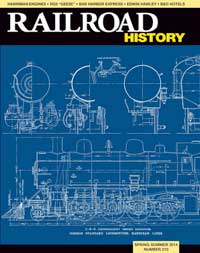 |
No. 210 Spring/Summer 2014 This is Railroad History’s summer vacation issue. We take you to Maine with Thornton Waite’s comprehensive history of the Bar Harbor Express. Smithsonian curator emeritus John H. White, Jr. recounts the story of three Maryland mountain retreats owned by the Baltimore & Ohio Railroad. John Gruber looks at William Henry Jackson’s work for railroad clients–much of which was used to promote rail travel to scenic destinations. Elsewhere, Scott Lothes of the Center for Railroad Photography & Art previews a new exhibition at the Chicago History Museum, focusing on the human side of photographer Jack Delano’s World War II-era work for the Farm Security Administration-Office of War Information. For readers with an interest in motive power, Joe Strapac profiles the Harriman 2-8-0s, and Stan Rhine explores the origins of the Rio Grande Southern Railroad’s beloved Galloping Geese. Cover: Erecting drawing came from the May 1905 issue of the American Engineer and Railroad Journal.Out of print |
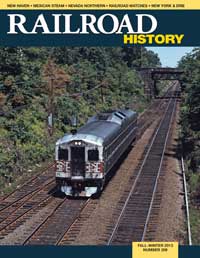 |
No. 209 Fall/Winter 2013 Geoff Doughty writes how the New York, New Haven & Hartford Railroad of the 1950s and ’60s faced a declining traffic base, diminished political influence, increasing costs, and the demands of both organized labor and the investment community. At the same time, public policymakers were coming to grips with the fact that the New Haven was an indispensible asset. This is the story of how the railroad and public officials came to devise new responses in the face of a dire threat. Photographer Frank Barry documents the last days of Mexican steam and he writes about his adventures in another culture. His photos are often arrestingly beautiful, and his experiences are delightfully amusing, like something from “Innocents Abroad.” Everything you ever wanted to know about railroad watches. Modern archaeology along the original New York & Erie Railroad. The rebirth of Nevada Northern 2-8-0 locomotive No. 93, a star of the 2014 R&LHS convention. Cover photo June 13, 1971, by George Drury |
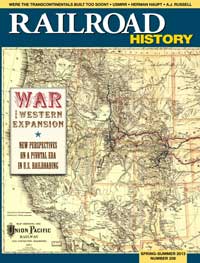 |
No. 208 Spring/Summer 2013 “Still Controversial: The Pacific Railroad at 150,” is a discussion among four eminent historians who offer widely divergent interpretations on the enduring meaning of transcontinental railroading. In this special event, organized by R&LHS, Maury Klein, Richard Orsi, T. J. Stiles, and Richard White share the results of their lifetime research. John Gruber gives us a retrospective on Andrew J. Russell, photographer of the Civil War and of the Union Pacific Railroad construction. Gruber shows that Russell’s work was a business development tool for UP and continues to be a useful historical resource–topics that scholars often ignore. Two articles cover Herman Haupt and the U.S. Military Railroads, but from different angles. Steven R. Ditmeyer recounts the critical role of Northern railroads in the Gettysburg campaign, and David Pfeiffer parts the curtain on primary source materials about Haupt and the USMRR at the National Archives. In the second and final excerpt from Albert Churella’s monumental history of the Pennsylvania Railroad, he shows how PRR tried and nearly succeeded in building a truly transcontinental empire. Jack Harpster profiles William Butler Ogden, the driving force in Chicago’s first railroad. |
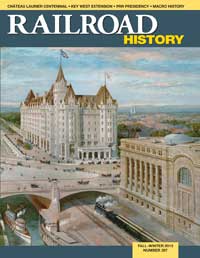 |
No. 207 Fall/Winter 2012 The Pennsylvania Railroad and the beginnings of the modern corporation: How a determined executive turned the PRR into something far greater than its founders envisioned. This is an excerpt from volume one of Albert Churella’s long-awaited two-volume history of the PRR, published with permission from the University of Pennsylvania Press. Also: Chateau Laurier, Canadian National Railway’s hotel in the federal capital of Ottawa. It was a statement that CNR was a national force with which to be reckoned. Finally, the military significance of Florida East Coast Railway’s Key West Extension, an overlooked dimension of an oft-told saga. |
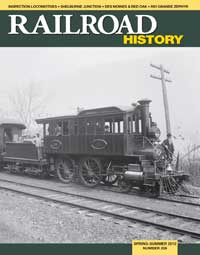 |
No. 206 Spring/Summer 2012 Inspection Locomotives: whether seating 4 or 94, these fascinating steam critters were an important part of railroading from earliest days until the diesel era. Almost always custom constructed, and usually home shop built and elegant, this is the definitive work on these curious and diverse machines. Shelburne, Mass. The R&LHS corporate clerk explains the relationship between the so-called greatest rail engineering feat of the 19th century and Society World Headquarters. Stillborn Interurban: Iowa’s Des Moines & Red Oak Railway. Zephyr Memories: A conversation with the train’s D&RGW’s manager Leonard Bernstein. |
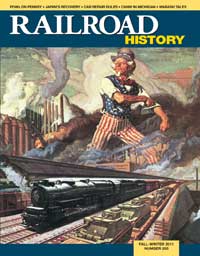 |
No. 205 Fall-Winter 2011 Tragedy and Recovery: This year’s earthquake and tsunami put Japanese engineering to the test. Car Repair Billing in the Information Age: How a PRR initiative ushered in a new era of railroad accounting. When German Prisoners of War Rode the Pennsy: Moving POWs to, and from, their U.S. camps during World War II. C&NW’s Origins in Michigan’s Upper Peninsula: Ore and timber were powerful lures for 19th-century builders. |
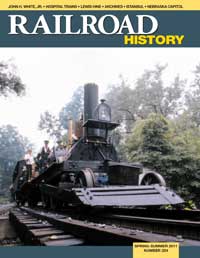 |
No. 204 Spring/Summer 2011 R&LHS honors one of its own: John H. White, Jr., is the dean of railroad historians, former transportation curator at the Smithsonian Institution, author of several authoritative reference works, and former editor of Railroad History. We’ll trace his career, and we’ll tell you why all of us are in his debt. The Warshaw Collection: an introduction to a little-known Smithsonian treasure trove. More archival gold, north of the U.S. border. The Bosporus crossing: noteworthy railroad architecture where Europe meets Asia. Railroads and the Nebraska state capitol. Medical railroading during the Korean War. |
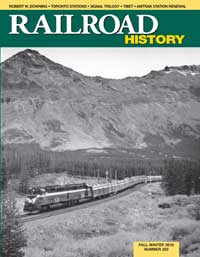 |
No. 203 Fall/Winter 2010 Don L. Hofsommer remembers the worthwhile life of Robert W. Downing. Derek Boles recounts the building, hiding, changing and destructing Toronto’s Victorian Railway Stations. We’ll also mark the retirement of America’s last interlocking tower and present two other stories on the development of train control technologies. And we venture beyond America’s borders to Canada and Tibet, in search of railroading old and new.Out of print |
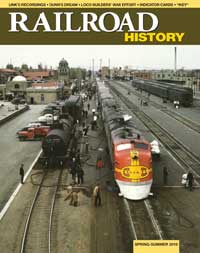 |
No. 202 Spring/Summer 2010 Tom Garver tells how he helped O. Winston Link produce his famous sound recordings. John H. White, Jr., returns with a look at a Big Four Route predecessor. Osama Ettouney of Miami University traces the origins of Africa’s first railroads in Railways Along the Nile. H. Roger Grant profiles a forgotten Iowa shortline that mirrored larger trends in American transportation. Preston Cook surveys the production and promotion of U.S. locomotive builders in World War II.Out of print. |
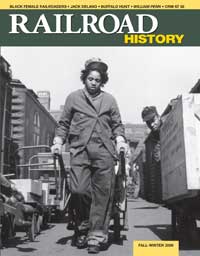 |
No. 201 Fall/Winter 2009 Railroads in the African American Experience: Through the permission of Johns Hopkins University Press, we present an extended excerpt from the forthcoming book by Theodore Kornweibel, Jr., professor emeritus of African American history at San Diego State University. Elsewhere in this issue, Cornelius Hauck observes the Colorado Railroad Museum’s golden anniversary; Tony Reevy continues our “Artist of the Rail” series with a profile of photographer Jack Delano; John H. White, Jr., writes of the Kansas Pacific Railroad and the demise of the American bison; Kyle Wyatt traces the history of an early California locomotive; and Ray State offers a new interpretation of the Delaware & Hudson’s first locomotives.Out of print. |
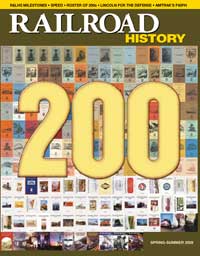 |
No. 200 Spring/Summer 2009 Special 200th issue. R&LHS president J. Parker Lamb provides glimpses of the organization’s past and looks at its future. You’ll also see rare photos from early R&LHS trips to Altoona, Eddystone, and more. Also included: a series of stories pegged to the number 200. You’ll read about the first 200-mph train, the first 200-km/h train, and Amtrak’s 200-series F40s. You’ll also find a complete roster of locomotives numbered 200, which provides a surprisingly representative cross-section of American motive power from earliest times to the present. And, because 2009 is the 200th anniversary of Abraham Lincoln’s birth, we present the story of Lincoln’s most famous case as you’ve never seen it before. |
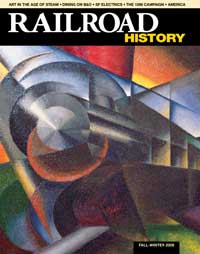 |
No. 199 Fall/Winter 2008 Art in the Age of Steam: An unprecedented museum exhibition shows how railroads changed the world that the great artists saw. Espee without cab-forwards: We tell you how close it came to happening. Managing B&O dining cars in the final years. Was the Stourbridge Lion really the first commercial locomotive in America? How the Lackawanna pioneered the use of radio for train operations. And, to wrap up the presidential election year of 2008, we look at how William Jennings Bryan used railroads to change the nature of campaigns. |
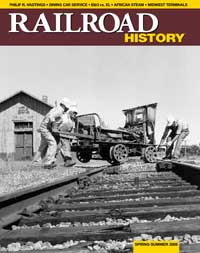 |
No. 198 Spring/Summer 2008 Philip R. Hastings, a talented observer of the railroad scene. Eastern ideologies: comparing Baltimore & Ohio and Erie Lackawanna as the two roads faced the challenges of the 1960s. Culinary attraction: how railroads used dining car service and amenities to attract passengers. Trouble in the Heartland: examining the demise of railroad passenger service on major Midwestern cities in the postwar era. |
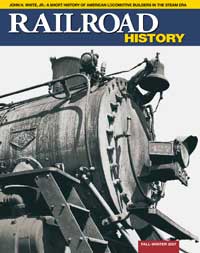 |
No. 197 Fall/Winter 2007 Special All-Steam presentation features a revised version of the John H. White, Jr,, 1982 book, A Short History of American Locomotive Builders in the Steam Era. The volume summarizes the histories of virtually every builder of American steam locomotives, including a compilation of production levels for most companies. The new edition includes many new photographs of steam power from the late 19th century to the end of production in the 1950s and incorporates digital renderings of rare drawings and engravings. Also new for this edition: biographical entries for 50 leading figures in the development of American steam power. This is a handsome reference edition for any serious student of steam.Out of print. |
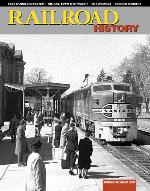 |
No. 196 Spring 2007 Why Cairo, Illinois, failed to become a great rail center. The golden age of highballing in the 1890s and its revival with the coming of streamliners. How Amtrak stacks up. NYC locomotive 999’s speed record is little documented. Steam’s last years in Colorado and Wyoming through the camera-eye of Richard Kindig. A McCloud River Railroad engineer takes a fond look at Baldwin’s 90-ton Mikados. A roster of 90-ton Baldwin Mikes used in North America. Coveted by E. H. Harriman and built to American standards by Imperial Japan, the South Manchuria Railway introduced modern railroading to the Orient. Engineer Joseph Santucci tells stories about his world and wins a world-wide audience on the web. |
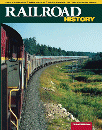 |
No. 195 Autumn 2006 The evolution of Canada’s passenger service 1945-2005. Six decades of rolling stock used by CNR, CPR, and VIA Rail. Serving the remote areas of Northern Manitoba. Update on crossing into Canada from the USA. Jimmy Rodgers was the singing brakeman. A Stroll Through Mount Clare Shops in 1872. Military escorts ride the rails in Pakistan. Monuments to Railroaders in Bronze and Stone. |
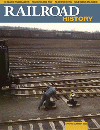 |
No. 194 Spring 2006 Meet Georgia & Florida, the hard luck line. Passenger trains and motive power on the “God Forgotten.” Profiles of forgotten railroad history authors. Alco building and taking orders of their pioneer high hoods. Jack Delano’s photos of men in Chicago wartime freight. The fight over Penn State’s coal traffic. Western Front tasks of the railroaders in the Great War. 4-4-0 Baldwins in Finland. |
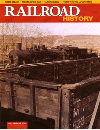 |
No. 193 Autumn 2005 The streetcars took a hit with the flood. Lucius Beebe pioneered the railfan book with colorful prose and pictures. Facts sometimes got in the way. The steam power that Soviet Russia gave to China started in America. A case study of technology transference. A connoisseur of steam returns to China for a last hurrah. Coal dust, Reshui, and other bittersweet adventures. How to counter the popularity of the automobile? SP&S tried coordinated bus-rail service on its Portland-Pacific Coast line. 19th-century builders take the lead in selling the image and mechanics of locomotives. Restoring the art of another age.Out -of-print |
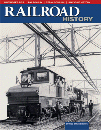 |
No. 192 Spring 2005 For close to a century, workers on the Wabash had enviable access to on-line hospitals. A 1905 account of Southern Pacific’s hospital car. Employee associations persist in a world of for-profit medicine. Railroad publisher and writer Zerah Colburn lost everything and died in disgrace. All about the railroad that burrowed under Baltimore and proved the practicality of main-line electric traction. Pigmy electrics plied their trade on the narrow streets of East Baltimore. From shad eggs to 60-pound sharks, fish traveled in cars designed for their safety and comfort. How woodcuts, engravings, lithographs, and printers’ trains spread the image of early railways to the masses. Recovering an important tranche of railroad records took organization, time, and elbow grease.Out of print. |
 |
No. 191 Autumn 2004 History of the Dome Car; Cuba and Railroads: Part 2: Fifty Years Too Soon; Aftermath of an Ohio interurbans cutting of coal rates; Railroad Soldiers: Thumbnail history of U.S. Military Railways; The Bridge that Never Was: Japan’s WWII Burma-Siam railway. |
 |
No. 190 Spring 2004 The Curve: Horseshoe Curve exerts staying power as an engineering feat and train-watching paradise; Cuba and Railroads: Part 1: Main Lines, 1837-2003; O. Winston Link; Requiem for a Runaway: In search of the remains of a Mallet that disappeared off Rollins Pass in 1924. |
 |
No. 189 Autumn 2003 Railroads and Slavery; Defeating Division 699: The 1916 railway strike in Washington, D.C.; Santa Fe’s Poster Genius; Loss at Kinzua: History of Kinzua Viaduct; David P. Morgan bio Part Two. |
 |
No. 188 Spring 2003 Too Big to Fail?: The political and regulatory mindset that led to Penn Central; Forgetting St. Louis and Other Map Mischief: The oddities and deception of railroad mapmaking; Trains Editor David P. Morgan bio: Part 1; Overwhelmed with Good Fortune: Sir Henry Tyler vs. the Vanderbilts in a gilded age battle for Chicago. |
 |
No. 187 Autumn 2002 Railroaders: Lives and Stories; Hitler’s Locomotives: Part 2; American Variety: Comparing engine classes here and abroad; The amiable New York & Greenwood Lake. |
 |
No. 186 Spring 2002 Rails Across the Hudson: Getting across the barrier, then and now; On the Waterfront: New York Harbor railroading in the 1950s and 1960s; Hitler’s Locomotives: Part 1; German Railroaders and the Holocaust; Strategic Short Line: All about South Carolina’s Columbia, Newberry & Laurens. |
 |
No. 185 Autumn 2001 Exclusive coverage of PATH operations during and after the terrorist attack of September 11, “Bravery at the WTC.” Plus Staggers Act deregulation, the saga of abandoned rail corridors, blue-collar “boomer” tales, Wheeling & Lake Erie locomotives, restoring the company town of Pullman, and discovering the beauty of dining-car menus. |
 |
No. 184 Spring 2001 Features wrecks, explosions, and pile-ups, a comprehensive history of railroad accidents and disasters, with eight articles, an exclusive list of notable accidents (1831-2000), and many photographs. Plus recently restored photographs of the Pennsylvania Railroad, steam on the Virginian Railway, and German-built diesel-hydraulic engines on the Southern Pacific. |
 |
No. 183 Autumn 2000 “Century Gone” by Tom Taber and Mark Reutter is a superb overview of the many changes in railroading in the 20th century, embellished with period timetables and posters. In addition, “Race to Chicago” details the rivalry between the Michigan Central and Michigan Southern to get to Chicago first; “Sahara’s Lost Railroads,” offers an account of desert railroads that once fueled Mussolini’s dreams and played a role in World War II; and “Semaphore Blades by Night” provides a missing chapter in the evolution of signaling. Plus, the issue features the stunning night photography of Ben Halpern. |
 |
No. 182 Spring 2000 The 4-8-4 locomotive by Robert A. Le Massena, with a gallery of historic action photos. Plus “The Railroad Pass: Perk or Plunder;” “Good Night, Madison,” an award-winning remembrance of growing up with tall tales and towermen in Wisconsin; a portrait of Henry U. Mudge, unsung Rio Grande mogul; and “Vanishing Triangles” on the New Haven. |
 |
The Diesel Revolution Special issue, published to critical acclaim in April 2000, on the conquest of the diesel locomotive (1920-1960, features original essays by Wallace W. Abbey, Robert Aldag, Albert J. Churella, Colin Divall, Don L. Hofsommer, Maury Klein, Jeffrey Meikle, William D. Middleton, and Mark Reutter. With trackside photographs by J. Parker Lamb and vintage EMC and Alco locomotive images. Already a collector’s item. |
 |
No. 181 Autumn 1999 A social and economic history of toy trains, from floor-running “dribblers” of the 1840s to the microprocessor locomotives. Also slavery on antebellum railroads, why the Union Pacific and Santa Fe did not electrify, and “Liquidating the Rock,” a personal account of dismantling the CRI&P. |